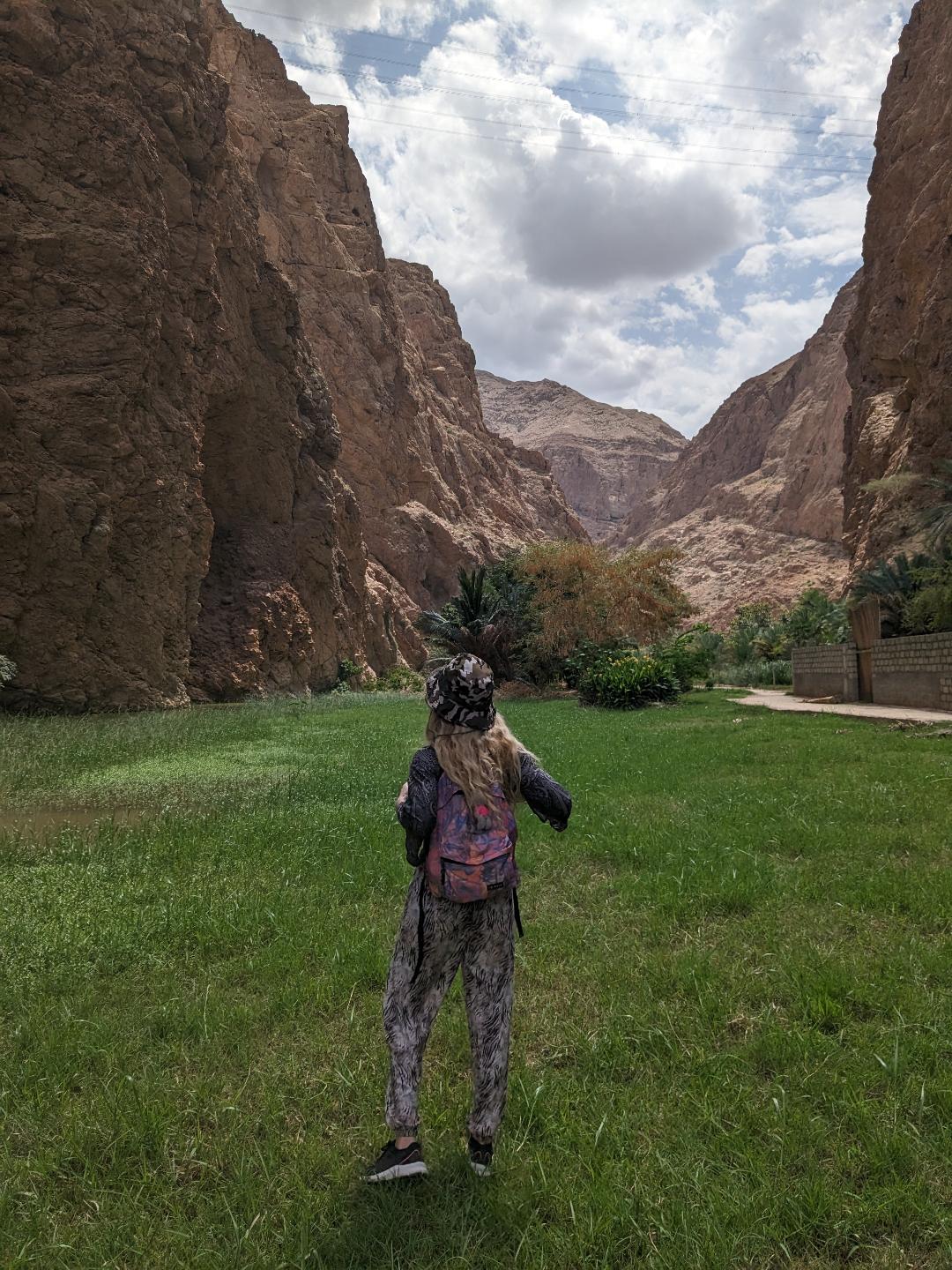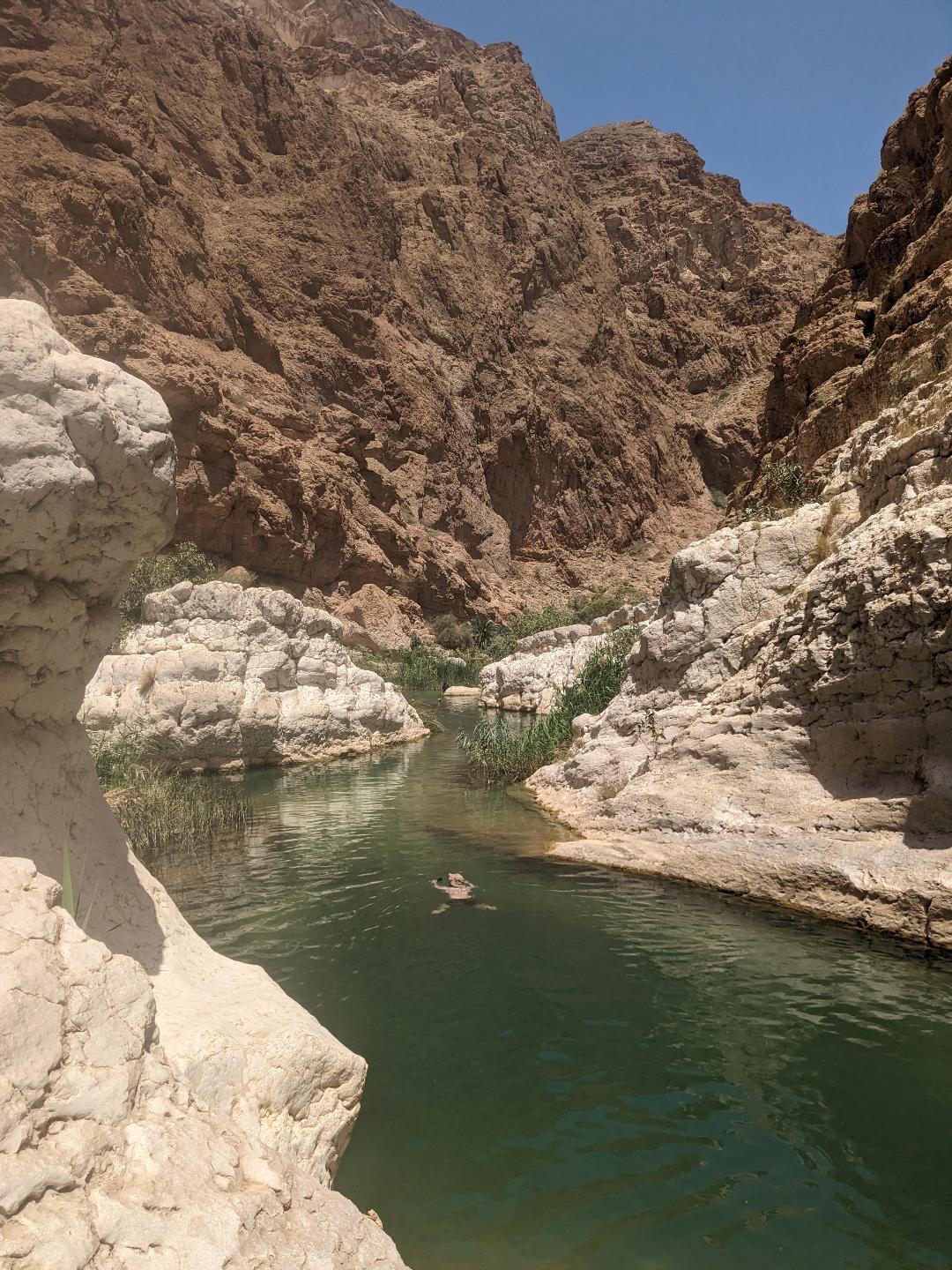Last updated on June 12th, 2025 at 09:00 am
Although we hail from our beloved island of Ireland, much of our full-time travel has led us back – again and again – to Asia.
There’s something magnetic about this vast continent that keeps us coming back. From towering mountains and ancient temples to vibrant cities and serene landscapes, Asia is a land of diversity and cultural depth that just never ceases to amaze us.
Having spent years exploring the far corners of Asia, we’ve created a list of the best landmarks in Asia – not just the obvious bucket list spots but those that moved us, surprised us, and made us fall even deeper in love with this part of the world.
While many travel guides tend to focus on South and Southeast Asia, this guide takes a broader view of the continent – highlighting must-see landmarks across all of Asia, from the jungles of Cambodia and the peaks of Nepal to the ancient wonders of Jordan and the hidden valleys of Oman. Our goal is to showcase the full geographic and cultural richness of Asia, including regions often overlooked in mainstream Asia travel lists.
Keep a pen and paper nearby to check off the ones you’ve visited or jot down the ones you’re now inspired to add to your Asia travel list!
1. Great Wall of China (China)
Let’s kick things off with what’s probably Asia’s most famous landmark. We typically avoid the “most famous attractions,” but even we can’t deny that visiting this iconic world wonder was a true “pinch-me” moment. It definitely earned its place on our list of the best landmarks in Asia.
Where is the Great Wall of China located: Northern China
Why the Great Wall of China is one of the best landmarks in Asia: The Great Wall of China is undoubtedly one of the best historical landmarks in Asia. Stretching over 20,000 kilometers, this incredible feat of engineering was built to protect the Chinese empire from invasions by nomadic tribes from the north. The Great Wall was constructed over several dynasties, with the most famous sections being built during the Ming dynasty.
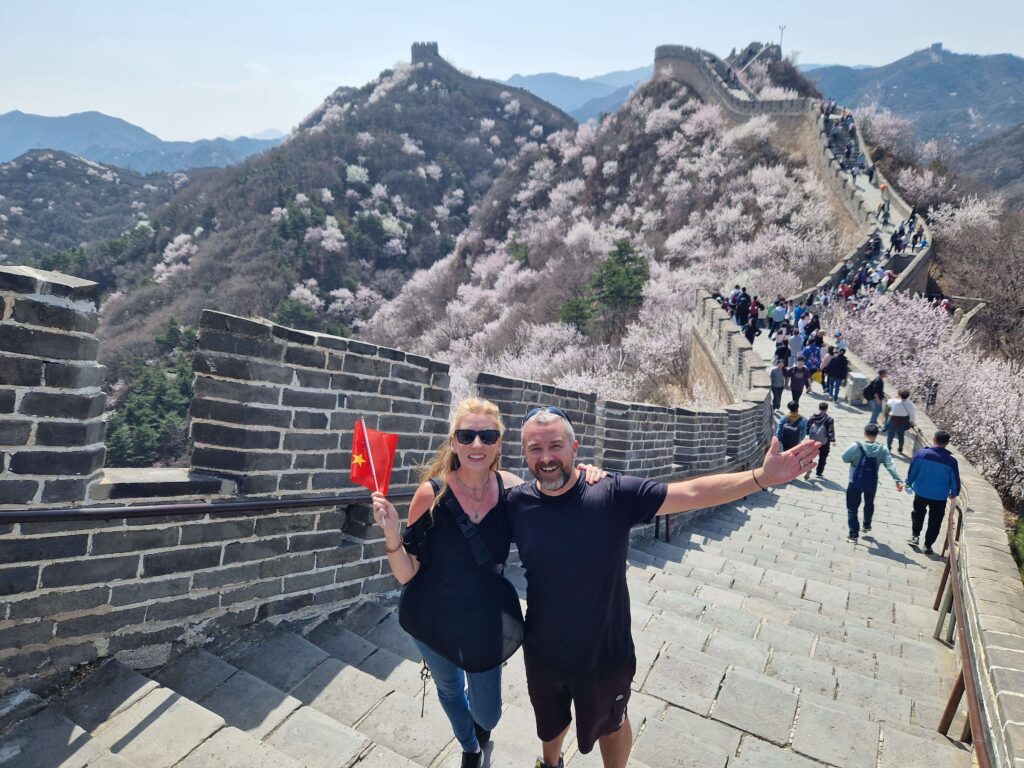
What to expect when visiting the Great Wall of China: Some of the best-preserved parts of the Great Wall of China, like Mutianyu and Jinshanling, offer stunning views and a chance to hike in a more serene atmosphere, away from the tourist crowds. Did you know you can ride a toboggan (or alpine slide) down from the Great Wall?! Welcome to China! You can ride a toboggan at the Mutianyu section near Beijing. It’s one of the most fun and unique ways to descend from the Great Wall of China after hiking up or taking the cable car. It’s a big hit with both kids and adults, making Mutianyu one of the more popular sections of the Great Wall for tourists – we’ve seen it all now!
Whether you hike, take a cable car or toboggan, the Great Wall of China is a must-see when exploring the best landmarks in Asia.
Top-rated Wall of China Tour:
- Discover the Great Wall on this tour from Beijing. Choose from many options, including VIP entry, a comfortable shuttle ride, a guided tour of the Great Wall, and a village-style buffet.
*Just a heads-up: some sections of the wall involve fairly steep climbs – poor Kate from Happy Irish Wanderers could barely walk for days after walking the Great Wall of China!
Find how to get to the Great Wall by Public Bus and how to visit the Great Wall of China on a Budget.
2. Wat Rong Khun – The White Temple (Thailand)
Where is Wat Rong Khun located: Chiang Rai, Thailand
Why Wat Rong Khun is one of the best landmarks in Asia: Unlike any other temple in the world, Wat Rong Khun is a jaw-droppingn blend of contemporary art and Buddhist symbolism. Designed by Thai artist Chalermchai Kositpipat, this all-white masterpiece is both a place of worship and a surreal visual experience that you have to see to believe. But what makes Wat Rong Khun truly stand out is the intense contrast of themes. As you walk across the bridge of the White Temple to the main hall, you pass a pit of outstretched hands – grotesque and grasping – representing unrestrained desire and the suffering of hell. It’s a dramatic and unsettling gateway that symbolizes the journey from human temptation and chaos toward enlightenment.
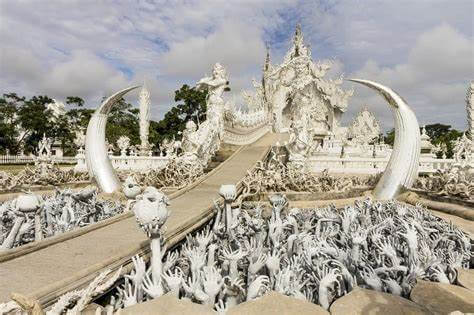
What to expect when visiting Wat Rong Khun: Expect to be stunned! Inside the White Temple, the murals are anything but traditional. Alongside depictions of heaven and Buddhist deities, you’ll spot unexpected figures like Darth Vader, Neo from The Matrix, Hello Kitty, and even nuclear explosions (yeah, you read that correctly!) From the eerie guardians at the entrance to the serene white stupas and the gold building out back (which, ironically, houses the most beautiful bathrooms in Asia!), every part of Wat Rong Khun is full of symbolism and thought-provoking contrasts. It’s not just a temple – the White Temple is an interactive spiritual message about morality, life, death, and rebirth and we can guarantee you will be left speechless, in the best way!
Top-rated Chiang Rai’s Wat Rong Khun Tour:
- Embark on a one-day adventure from Chiang Mai to the captivating city of Chiang Rai. Visit the White and Blue Temple, enjoy the Mae Kachan Hot Springs, and visit the Hill Tribe Long Neck village.
As you can imagine, we have visited a LOT of temples over the years, but Thailand’s White Temple in Chiang Rai is hands-down the most unique temple in Asia.
Thailand is one of our all-time favorite countries – we’ve returned to this Southeast Asian paradise more times than we can count. To help you make the most of your trip, don’t miss our ultimate Thailand itinerary packed with the very best experiences, destinations, and hidden gems the country has to offer.
3. Angkor Wat (Cambodia)
Where is Angkor Wat located: Siem Reap, Cambodia
Why Angkor Wat is one of the best landmarks in Asia: Angkor Wat is the largest religious monument in the world and an awe-inspiring architectural masterpiece. Originally built as a Hindu temple dedicated to the god Vishnu in the early 12th century, Angkor Wat was later converted to a Buddhist temple. Angkor Wat is not only a UNESCO World Heritage Site but also a powerful symbol of Cambodian national identity featured prominently on the country’s flag. It’s a stunning example of Khmer architecture and one of the best landmarks in Asia to explore if you’re interested in Cambodian history and culture.
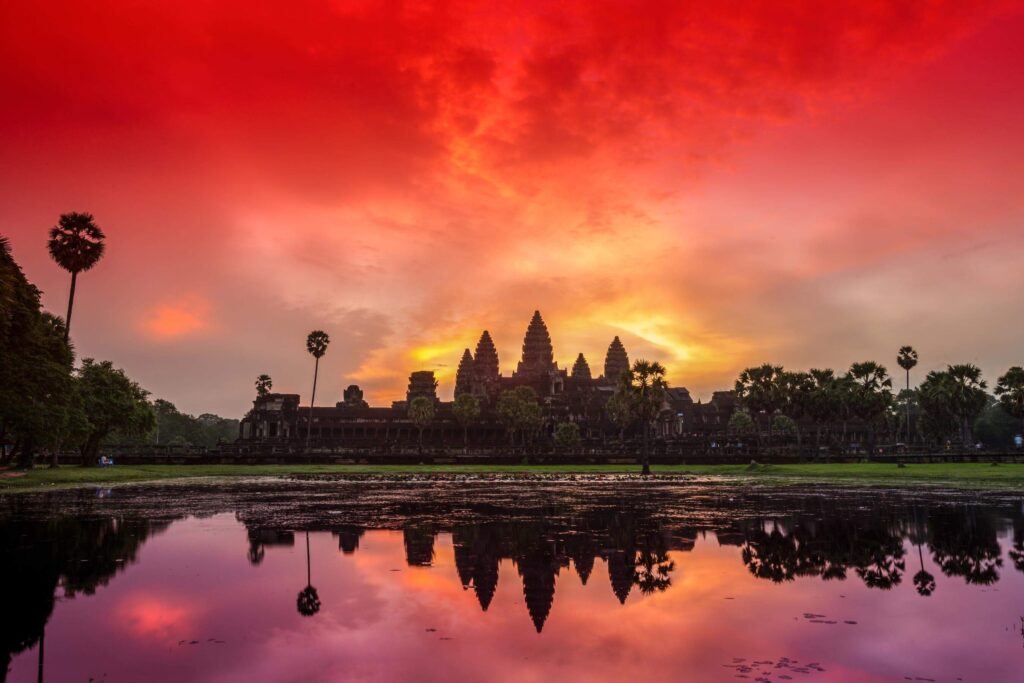
What to expect when visiting Angkor Wat: The central structure of Angkor Wat is a massive, three-tiered temple mountain surrounded by a wide moat, with five prominent towers rising dramatically into the sky – especially stunning at sunrise. Visiting Angkor Wat at sunrise is a particularly magical experience, with the silhouette of the temple reflecting in the surrounding moat (see picture above!) While Angkor Wat is the crown jewel, the Angkor Archaeological Park is a vast UNESCO World Heritage Site covering over 400 square kilometers and includes dozens of ancient temples and structures, making it one of the most important archaeological sites in Southeast Asia. When visiting the Angkor Archaeological Park, expect to explore a wide range of temples, including Bayon, known for its massive stone faces gazing in all directions; Ta Prohm, (our favorite Angkor temple)famously overgrown with tree roots and featured in the movie Tomb Raider, and Preah Khan, a sprawling monastic complex. Each site in Angkor Archaeological Park reveals different aspects of Khmer architecture, religion, and daily life, and no doubt Angkor Wat should be on your list of best places to visit in Asia.
Top-rated Angkor Wat Tour:
- Watch the sunrise over Angkor Wat with this truly unforgettable experience. Explore the Angkor complex, including the jungle temple of Ta Prohm, before the crowds arrive and get some amazing pictures.
Angkor Wat ranks in our top three favorite places in the world – and that’s saying something. But discover more unique destinations we consider to be the most beautiful places on Earth.
4. Erawan Falls (Thailand)
Location: Erawan National Park, Kanchanaburi Province, Thailand
Why Erawan Falls is one of the best landmarks in Asia: The stunning Erawan Falls is one of Thailand’s most beautiful natural landmarks and a must-see for any traveler exploring Asia. Located in the Erawan National Park in Kanchanaburi Province, the Erawan Falls are known for their vivid emerald green waters and seven-tiered cascade that stretches across the lush jungle landscape.
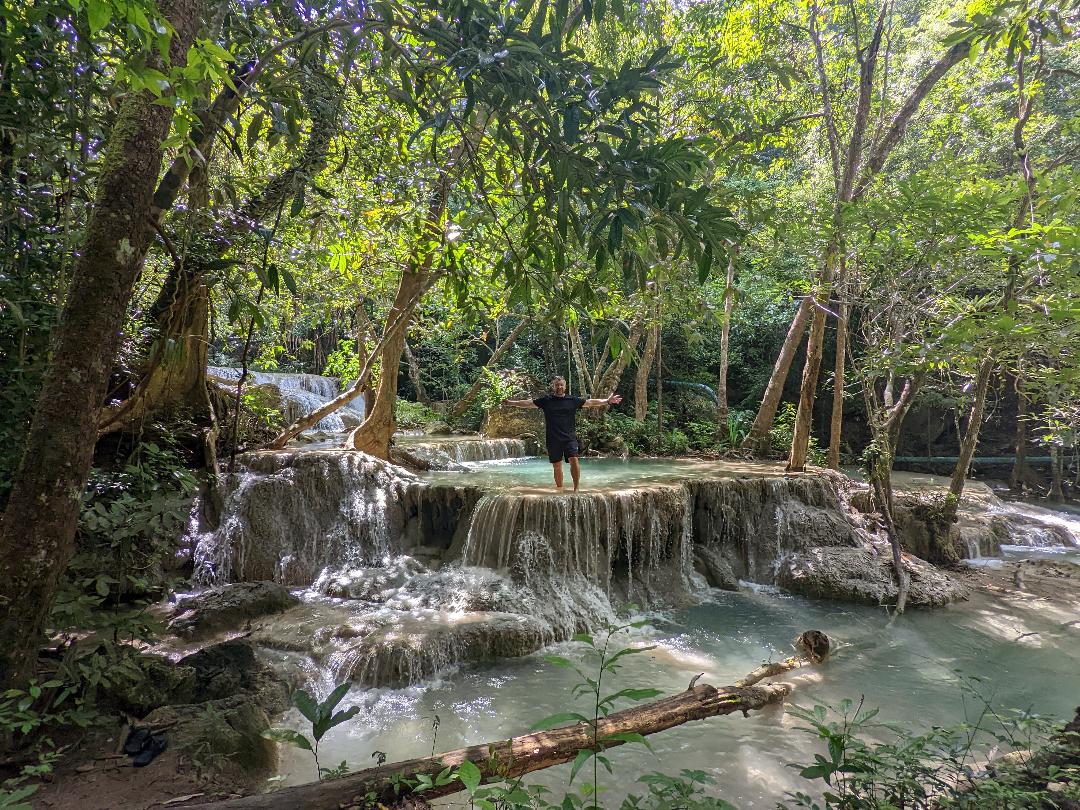
What to expect when visiting Erawan National Park: Erawan Falls is made up of seven levels, each with its own beautiful, turquoise-blue pool created by limestone deposits that give the water its signature color. Tiny fish swim in the pools, occasionally giving your feet a gentle nibble if you sit still – a quirky, natural “fish spa” experience. (The presence of these fish is something to note so you are not the two Irish screeching and making a scene in this otherwise serene Thailand paradise!) Some tiers have small cascades, while others have larger drops, and each level feels a little different as you go higher up. The hike to the top of Erawan Falls is approximately 1.5 kilometers, with the first few tiers easily accessible and the upper tiers requiring a bit more effort – but believe us it will be worth it. As one of the best landmarks in Asia for nature lovers, Erawan Falls provides an unforgettable escape into the heart of Thailand’s wild beauty and is, for sure, the most beautiful waterfall in Thailand.
Top-rated Erawan National Park Tour:
- From Bangkok: Erawan Park & Kanchanaburi Small-Group Tour
If you’re a fan of waterfalls, don’t miss our list of the 10 most beautiful waterfalls in world.
5. Mount Fuji (Japan)
Where is Mount Fuji located: Honshu Island, Japan.

Why Mount Fuji is an iconic natural landmark in Asia: Mount Fuji, Japan’s highest peak, is both a sacred site and a symbol of the country’s beauty and serenity. For centuries, it has inspired artists, poets, and spiritual seekers. Standing at 3,776 meters, Mount Fuji is one of the most famous landmarks in Asia.
What to expect when visiting Mount Fuji: Whether you choose to climb Mount Fuji or view it from one of the nearby lakes, this iconic site in Japan will take your breath away. The best landmarks in Asia don’t just showcase man-made wonders – nature’s wonders like Mount Fuji hold a unique magic, especially during the winter when the snow-capped peak is at its most majestic.
Top-rated Mount Fuji Tour:
- From Tokyo: Mount Fuji Top 4 Must-Visit Attractions Day Tour
6. Bagan (Myanmar)
Where is Bagan located: Central Myanmar
Why Bagan is one of the best landmarks in Asia: Bagan is one of the most amazing places in the world and our favorite place in Asia!! Ok, now that we have your attention let’s find out what Bagan actually is. It’s a spiritual landscape unlike any other in Asia, offering a glimpse into Myanmar’s rich Buddhist heritage. Bagan is home to over 2,000 Buddhist temples, stupas, and pagodas scattered across a vast plain. These ancient temples were constructed between the 9th and 13th centuries, and the site remained a thriving center of culture and religion until the 18th century.
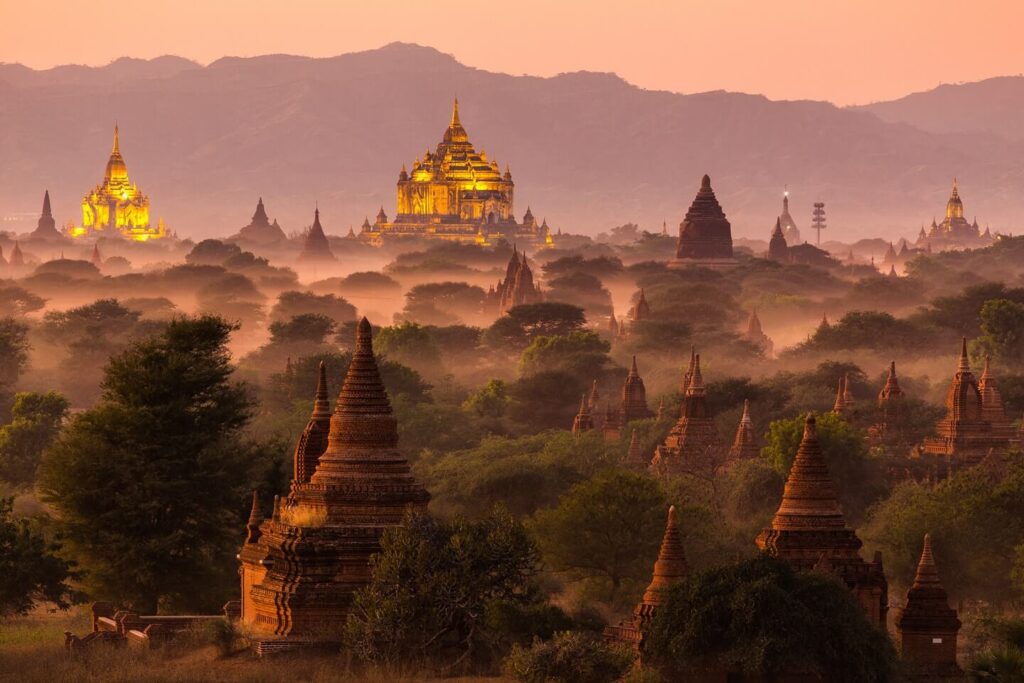
What to expect when visiting Bagan: Visiting Bagan, in central Myanmar, is like stepping into a dreamscape of ancient temples scattered across a vast, open plain. The first thing you’ll notice is the sheer number of temples – some grand and towering, others small and half-hidden among trees – spread across a dusty, golden landscape that glows in the morning and evening light. Most visitors explore Bagan by e-bike, bicycle, or with a local guide, as the temples are spread out over a wide area. Bagan sunrise and sunset views are a must-see attraction in Myanmar – watching the first or last light of day bathe the temples in gold and orange is one of the most memorable experiences you can have. Inside the temples, you’ll find Buddha statues, ancient murals, and carvings that tell stories from Buddhist teachings. The atmosphere of Bagan is peaceful and spiritual, with fewer crowds compared to other popular tourist sites in Southeast Asia. You’ll also find charming local villages, markets, and friendly people who are often happy to share stories about their heritage and culture. Bagan is easily one of the most magical places on Earth, and we strongly recommend adding this lesser-known gem to your list of must-see landmarks in Asia.
Think exploring the thousands of ancient temples in Bagan is magical? Now imagine soaring above them in a hot air balloon – it’s an unforgettable experience that takes the magic of Bagan to a whole new level.
Top-rated Bagan Tour:
- Golden Eagle Hot-Air Ballooning in Bagan – The best way by far to take in the vast array of temples in Bagan is on a hot-air balloon ride. Head to the skies and float over thousand-year-old pagodas and the mighty Ayeyarwaddy River, as the sun rises slowly from behind distant mountains.
Top Bagan Tip: Keep a close eye on your e-bike’s battery level when exploring Bagan’s temples – the last thing you want is to be having too much fun and end up stranded as the sun sets, like us, and have to rely on a kind local to tow you back to your Bagan hotel!
7. Petra (Jordan)
Where is Petra located: Though often thought of as part of the Middle East, Petra is located in Southern Jordan, which lies in Western Asia – making this ancient wonder a lesser-known but rightful entry among Asia’s top landmarks.
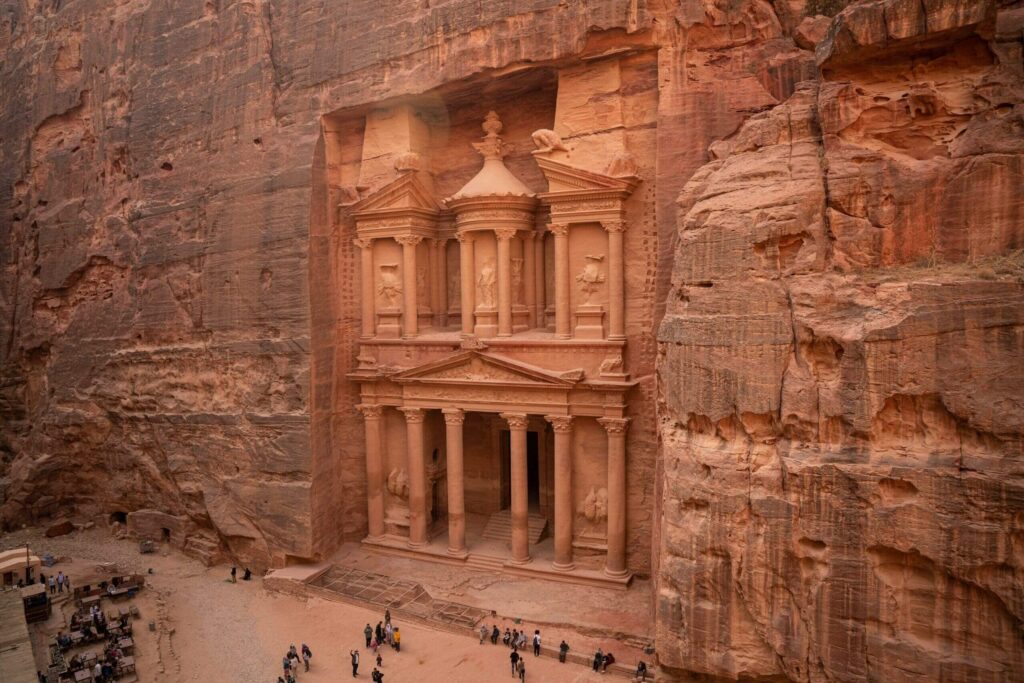
Why Petra is one of the best landmarks in Asia: Carved directly into the rose-red sandstone cliffs, Petra was the capital of the Nabataean Kingdom around 2,000 years ago and is now one of the most iconic archaeological sites in the world – and a UNESCO World Heritage Site. This Asian archaeological wonder is an ancient city that’s both visually stunning and historically significant.
What to expect when visiting Petra: You’ll start your visit to Petra by walking through the Siq, a narrow, winding gorge surrounded by tall rock walls. This dramatic entrance of Petra sets the tone, and as you reach the end, the view suddenly opens to reveal the Treasury (Al-Khazneh) – Petra’s most famous facade. It’s a moment that feels straight out of an adventure movie (in fact, it famously appeared in Indiana Jones and the Last Crusade). But Petra is much more than just the Treasury. The site covers a vast area, with tombs, temples, staircases, and rock-cut buildings spread throughout the desert landscape. You can hike up to the Monastery (Ad-Deir), another massive carved structure with fewer crowds and stunning views, or climb to the High Place of Sacrifice for panoramic scenes over the valley. Whether you’re drawn by its archaeology, its landscape, or its legendary atmosphere, Petra is an unforgettable destination in Asia that lives up to – and often exceeds – its reputation, making it one of the best landmarks in Asia to discover.
Top-rated Petra Tour:
- Visit the ancient rock-carved city of Petra on a 2-day tour from Amman. Float in the mineral-rich water of the Dead Sea and discover the beauty of Wadi Rum by spending the night in a Bedouin camp.
Top Petra Travel Tip: If you choose to visit Petra consider purchasing the Jordan Pass. This pass grants you access to over 40 Jordan attractions, including Petra, and covers your Jordan visa fee as well. The Jordan Pass starts from $78. Considering the minimum entrance fee of $56 for Petra and the $45 visa fee, the Jordan Pass offers a more cost-effective option.
8. Wadi Shab (Oman)
Where is Wadi Shab located: Tiwi, Al Sharqiyah South Governorate, Oman. Though often associated with the Middle East, Oman – similarly to Jordan – is part of Western Asia, making its dramatic landscapes and hidden wadis a surprising but fitting addition to any list of Asia’s top natural landmarks.
Why Wadi Shab is one of the best landmarks in Asia: Wadi Shab is a stunning natural wonder in Oman, a wadi – a dry riverbed or valley – nestled between rugged cliffs and desert landscapes. Known for its breathtaking beauty, this picturesque gorge is home to crystal-clear turquoise pools, dramatic rock formations, and a hidden waterfall cave. As one of Oman’s most remarkable landmarks, Wadi Shab offers a unique, off-the-beaten-path adventure and is easily one of Asia’s lesser-known gems that’s definitely worth visiting.
What to expect when visiting Wadi Shab: When you visit Wadi Shab in Oman, you’re in for a mix of adventure and relaxation. After a short boat ride across the river, a scenic 45-minute hike takes you through date palm groves and rocky paths to crystal-clear swimming holes. The hike through Wadi Shab is a highlight in itself. However, the main attraction in Wadi Shab is a hidden waterfall inside a cave, which you can swim through to reach a peaceful pool – a truly unforgettable experience in Oman. Whether exploring the pools, hiking, or simply soaking in the views, Wadi Shab offers an incredible escape into Oman’s nature.
Top-rated Wadi Shab Tour:
- From Muscat: Wadi Shab & Bimmah Sinkhole Full-Day Tour
Find out more of the best things to do in Oman – you will be amazed at what this lesser-visited Asian country has to offer.
9. Charyn Canyon (Kazakhstan)
Where is Charyn Canyon located: Almaty Region, Kazakhstan.
Why Charyn Canyon is one of the best landmarks in Asia: Often referred to as the “Grand Canyon of Central Asia,” Charyn Canyon is a breathtaking natural wonder that showcases the rugged beauty of Kazakhstan. Spanning over 154 kilometers along the Charyn River, the canyon features deep gorges, towering cliffs, and remarkable rock formations. Its striking red-hued landscape and dramatic contours make it one of Asia’s most underrated natural landmarks. With its surreal beauty and relatively remote location, Charyn Canyon is one of Central Asia’s hidden gems, offering a unique and less crowded alternative to more famous destinations like the Grand Canyon.
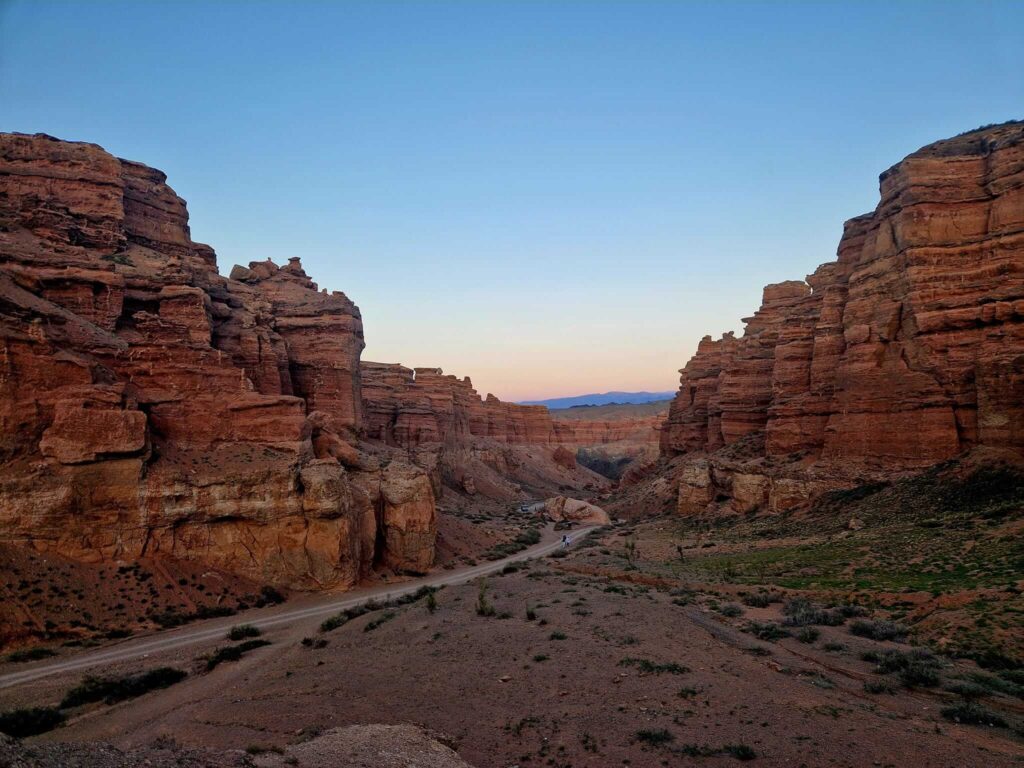
What to expect when visiting Charyn Canyon: When visiting Charyn Canyon, expect a jaw-dropping natural landscape that feels almost otherworldly. The lesser-known canyon’s vibrant red and orange rock formations create a stunning contrast against the clear blue sky, especially at sunrise and sunset. As you explore Kazakhstan’s famous canyon, you’ll encounter deep gorges, steep cliffs, and unique formations like the “Valley of Castles”, where the towering rocks resemble ancient fortresses. You can hike through Charyn Canyon along various trails, some leading to the riverbanks for a more peaceful experience as you take in the breathtaking views carved by nature over millions of years. Visiting Charyn Canyon is an unforgettable adventure for those seeking to step off the beaten path and discover a hidden gem in Kazakhstan.
Top-rated Charyn Canyon Tour:
- Discover the natural treasures of Almaty on this guided day trip. Marvel at the peaceful Kaindy and Kolsai lakes before exploring the towering cliffs and red rocks of Black and Charyn Canyons.
10. The Himalayas (Nepal/Bhutan/Tibet/India)
Where are the Himalayas located: The Himalayas stretch across several countries in South Asia. You can trek the Himalayas in Nepal, India, Bhutan, Tibet (China), and Pakistan.
Why The Himalayas are one of the best natural landmarks in Asia: The Himalayas should be on everyone’s list of the best landmarks in Asia because they represent the continent’s most iconic and awe-inspiring natural wonder. As the highest mountain range in the world, the Himalayas not only offer some of the most breathtaking landscapes but also play a vital role in shaping the region’s climate, culture, and ecosystems. They are home to sacred sites, diverse wildlife, and challenging trekking routes that attract adventurers from around the globe. Beyond their sheer physical beauty, the Himalayas hold deep spiritual and cultural significance, making them a must-see Asian landmark for anyone wanting to experience the true essence of Asia.
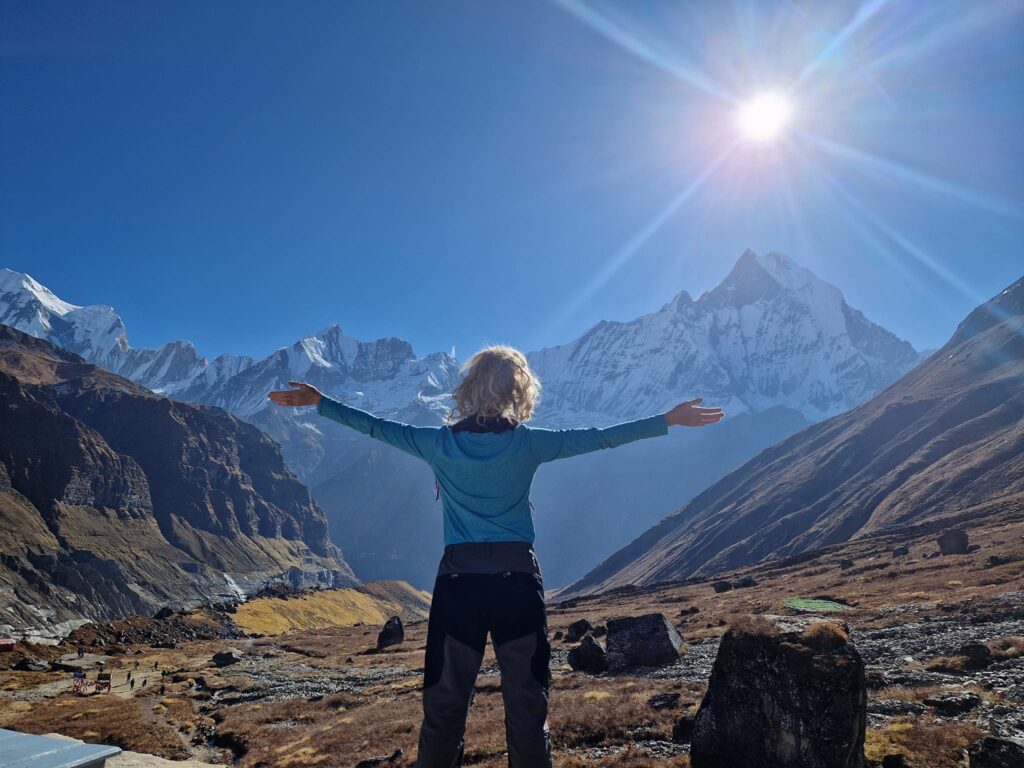
What to expect when visiting the Himalayas: While it’s difficult to fully describe what to expect from a journey through the Himalayas, as every experience is unique, there are a few things that remain constant. You can expect stunning, ever-changing landscapes, from lush valleys and alpine meadows to dramatic, snow-capped peaks. The physical challenge of trekking the Himalayas’ rugged terrain is part of the adventure, but so is the sense of accomplishment when you reach new heights. Whether you’re passing through remote mountain villages, visiting sacred sites, or simply standing in awe before some of the world’s highest peaks, the Himalayas will leave you with a profound sense of connection to nature and yourself.
Your personal journey will be shaped by your pace, your route, and your perspective, but one thing is for sure – no matter how you experience it, the Himalayas are sure to leave a meaningful mark on your soul – all contributing to its status as one of the best natural landmarks in Asia.
Happy Irish Wanderers experienced the breathtaking Himalayas during our visit to Nepal, where we embarked on a 6-day trek to Annapurna Base Camp. This ABC trek was a true adventure, offering stunning views, challenging climbs, and unforgettable moments in one of the most iconic mountain ranges in the world.
You can read all about our Himalayan adventure in the related articles:
- 6-Day Annapurna Base Camp Trek WITHOUT a Guide: Best Advice From Permits to Packing
- Easily Get Your Permit for the Annapurna Base Camp Trek: UPDATED info
- Nepal Holiday: 13 Best Things You Need to Know Before You Visit
- Is Pokhara Worth Visiting? Everything You Need to Know Now
11. Borobudur (Indonesia)
Where is Borobudur located: The island of Java, Indonesia
Why Borobudur Temple is one of the Best landmarks in Asia: Borobudur is the largest Buddhist monument in the world, built in the 9th century. This enormous temple complex in Indonesia is designed as a giant mandala, representing the Buddhist path to enlightenment.
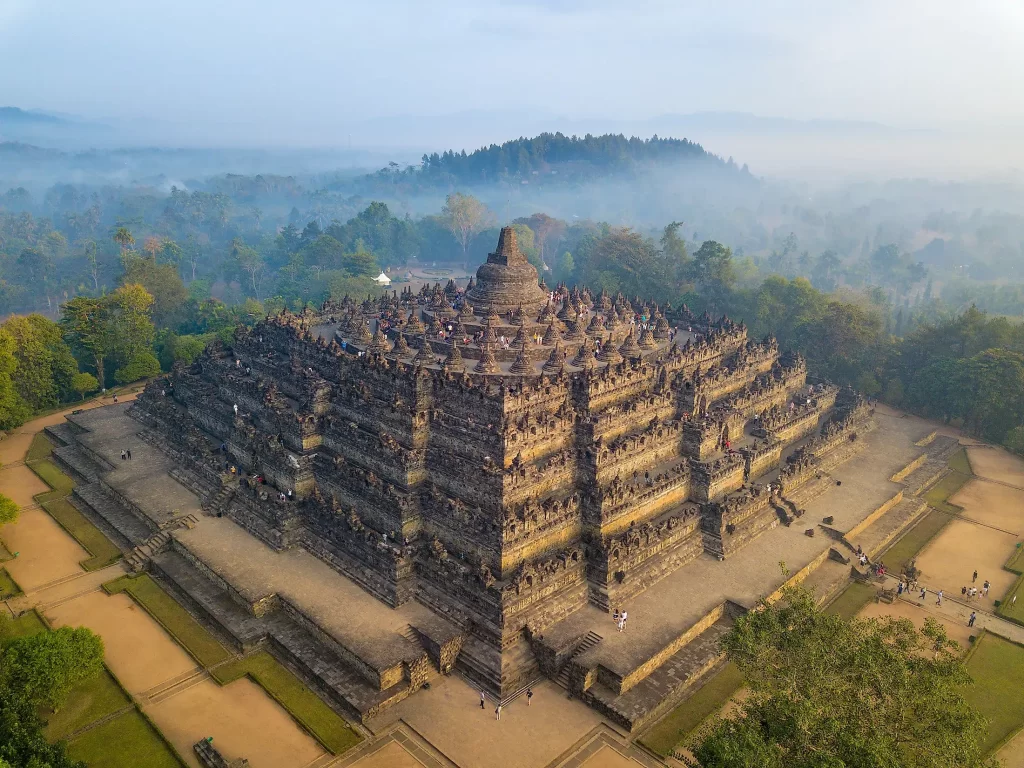
What to expect when visiting Borodur Temple: At the top of Borobudur Temple, you’ll see dozens of stone bell-shaped structures called stupas, each with a Buddha statue inside. Some are partially open so you can see the Buddhas, while others are fully enclosed with carved patterns. It’s a peaceful and impressive sight, especially with the misty views all around. Visitors can hike up early to watch the sunrise over the monument. The intricate carvings and panoramic views make this one of the must-see landmarks in Asia.
In our opinion, Java is the best island in Indonesia, so do yourself a favor and check out all the best things to do in Java. You will thank us later – some of Asia’s most unforgettable attractions are waiting for you in Java.
12. Mount Bromo (Indonesia)
Where is Mount Bromo located: The island of Java, Indonesia (again!)
Why Mount Bromo is one of the best landmarks in Asia: Mount Bromo is an active volcano in East Java within the Bromo-Tengger-Semeru National Park, surrounded by a surreal “Sea of Sand.” This fiery Asia landmark is a natural wonder, offering one of the most dramatic sunrise experiences in Asia. In addition to Mount Bromo’s breathtaking landscapes, it holds deep cultural and spiritual significance for the Tenggerese people, who perform a unique Yadnya Kasada ceremony, offering sacrifices to the mountain gods. This combination of natural wonder and cultural richness makes Mount Bromo a must-see landmark in Asia.
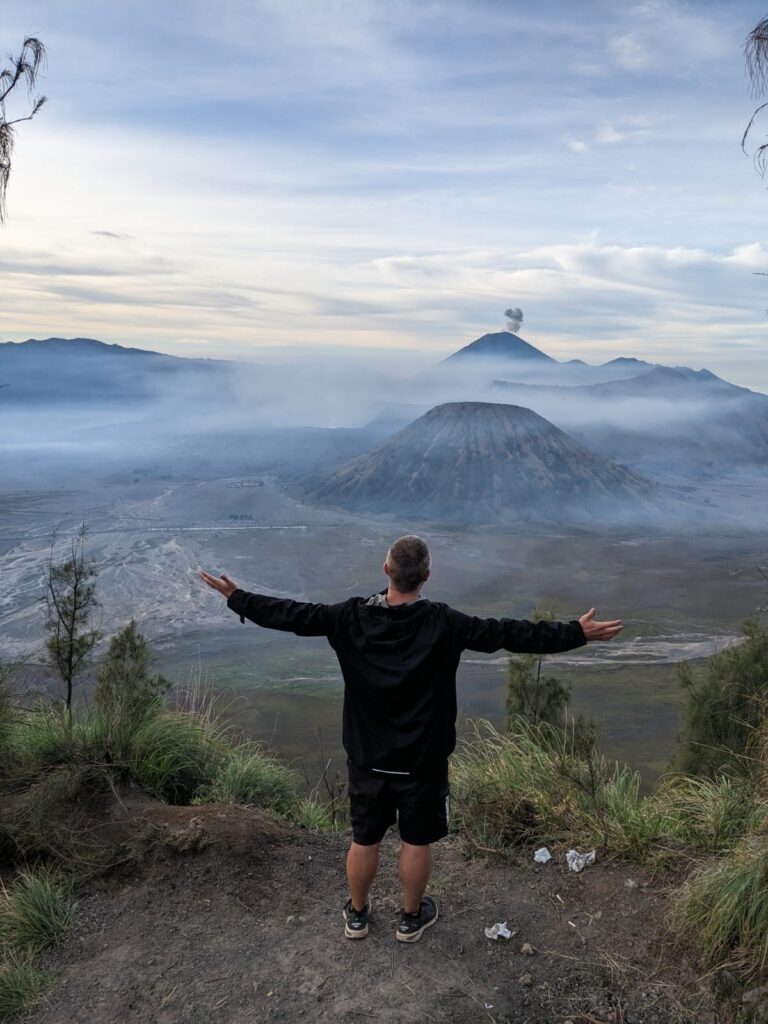
What to expect when visiting Mount Bromo: The best way to experience Mount Bromo is to start with the Mount Bromo sunrise hike, followed by a visit to the crater itself. The adventure begins early – usually around 3 a.m. – as you head to King Kong Hill viewpoint to watch the famous MOunt Bromo sunrise. From there, you’ll witness a truly breathtaking scene: the first light of day spilling over a surreal landscape of smoking craters, volcanic peaks, and a mist-covered sea of sand. Once the sun is up and the view has settled in, you can make your way down into Bromo-Tengger-Semeru National Park and take a short walk up to Mount Bromo’s crater. Standing at the rim, you’ll look directly into the steaming heart of the volcano, with panoramic views of the dramatic volcanic terrain all around you – Now that’s a view truly worthy of a spot on any list of the best landmarks in Asia!
You can read all about our visit to Mount Bromo – we did mention that we think Java is the best island in Indonesia! And we haven’t even included other amazing Java attractions such as the world’s largest acid lake, and the easily most beautiful waterfall in Indonesia!
Even though we come from the beautiful island of Ireland, at this point in our travels we’ve probably written more about Indonesia than anywhere else. It’s a country that completely captured our hearts. If you’re planning a trip, be sure to dive into our Indonesia travel guides – they’re packed with our favorite spots, hidden gems, and itineraries we’ve loved.
13. Sigiriya (Sri Lanka)
Where is Sigiriya located: Central Sri Lanka.
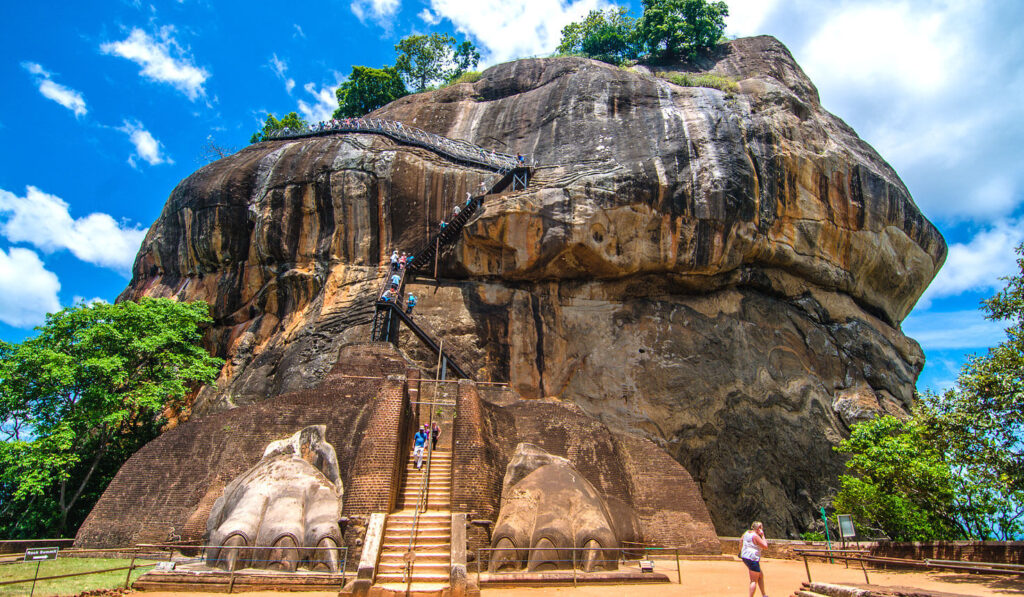
Why Sigiriya is one of the best landmarks in Asia: Sigiriya, also known as Lion Rock, is one of Sri Lanka’s most iconic landmarks and a UNESCO World Heritage Site. This ancient rock fortress rises dramatically nearly 200 meters above the jungle in the country’s Central Province and was once the site of a royal palace built by King Kashyapa in the 5th century. Today, visitors can climb to the top of Sigiriya for sweeping panoramic views and explore the fascinating ruins
What to expect when visiting Sigiriya: When visiting Sigiriya, you can expect a blend of history, adventure, and incredible views. The visit begins with a walk through beautifully landscaped water gardens, ancient moats, and stone pathways leading to the base of Sri Lanka’s massive rock. As you start the climb of Sigiriya, you’ll pass centuries-old frescoes painted on the rock walls and the Mirror Wall, once polished so finely it reflected the king’s image. About halfway up, you’ll reach the famous Lion’s Paw Terrace, where enormous stone paws guard the final stairway to the summit of Sigiriya. The climb can be steep and involves narrow staircases, but it’s manageable for most visitors and well worth the effort. At the top of this Lion Rock, you’ll be rewarded with breathtaking panoramic views of Sri Lanka’s surrounding jungle and countryside, as well as, the ruins of the ancient palace complex. In our opinion, Sri Lanka’s Sigiriya is one of the best landmarks in Asia.
Top-rated Sigiriya Tour:
- Discover the historic rock fortress of Sigiriya and explore the cave complex on a day trip from Colombo. Get picked up directly from your hotel and enjoy a small group tour and wild safari.
On a side note, does Sri Lanka have the most affordable food in Asia? Find out more about how we eat cheap around the world.
14. Zhangjiajie National Forest Park (China)
Where is Zhangjiajie located: Hunan Province, China
Why Zhangjiajie Nationial Forest Park is one of the best landmarks in Asia: It’s no surprise we gravitate toward natural wonders, and Zhangjiajie stands out as one of Asia’s most surreal landmarks. Its otherworldly sandstone pillar landscape, made famous as the inspiration for Avatar, along with record-breaking attractions like the Bailong Elevator and the Glass Bridge, make Zhangjiajie the most unique destination in China. As a UNESCO Global Geopark, it offers rich biodiversity, deep cultural heritage from local ethnic groups, and a perfect mix of adventure and natural beauty – making it a truly unforgettable destination in Asia.

What to expect when visiting Zhangjiajie National Forest Park: Visiting Zhangjiajie is like stepping into another world, with its towering sandstone pillars, misty peaks, and breathtaking natural formations. Within Zhangjiajie National Forest Park you can ride the Bailong Elevator, the world’s tallest outdoor glass elevator, and explore areas like Tianzi Mountain and Yuanjiajie, both offering stunning panoramic views. Another must-see is Tianmen Mountain, accessible via the world’s longest cable car ride from the city of Zhangjiajie. At the summit, visitors can brave the glass skywalks that cling to the mountain’s edge and marvel at Tianmen Cave, a massive natural arch known as Heaven’s Gate. The Zhangjiajie Grand Canyon, home to the world’s longest and highest glass bridge, offers yet another thrilling experience for adventure lovers.
Let’s just say you won’t be lost for things to do when visiting Zhangjiajie National Forest Park! All in all, Zhangjiajie offers a mix of natural wonder, cultural intrigue, and thrilling experiences that make it one of China’s most unforgettable destinations, and you guessed it, one of the best landmarks in Asia!
Top-rated Zhangjiajie National Forest Park Tour:
- Explore Zhangjiajie National Forest Park with VIP access. Enjoy queue-free entry, a private vehicle, and a personal guide for a tailored, exclusive tour. (trust us when you see some of the queues at these China attractions you will be delighted with your decision to opt for a queue-free entry!)
We watched Avatar together on our very first date at the cinema, so getting to visit the real-life landscape that inspired the film – 15 years later – was incredibly special. Standing among the towering sandstone pillars of Zhangjiajie felt like stepping into another world. It’s without a doubt one of the most breathtaking places on Earth and an absolute must-see when visiting China.
15. Living Root Bridges (India)
Where are the Living Root Bridges located: Meghalaya, Northeast India
Why Meghalaya’s Living Root Bridges are one of the best landmarks in Asia: The living root bridges of Meghalaya, India, earn their place among Asia’s most unique landmarks for their remarkable blend of nature and human ingenuity. Built out of necessity by the Khasi and Jaintia tribes to withstand the region’s relentless monsoon rains and swollen rivers, these bridges were created by guiding the aerial roots of rubber trees across streams and ravines. Unlike conventional structures, they grow stronger over time, can last for centuries, and exist in perfect harmony with their rainforest surroundings – making them a rare and sustainable example of bioengineering and cultural tradition. How cool is that?!
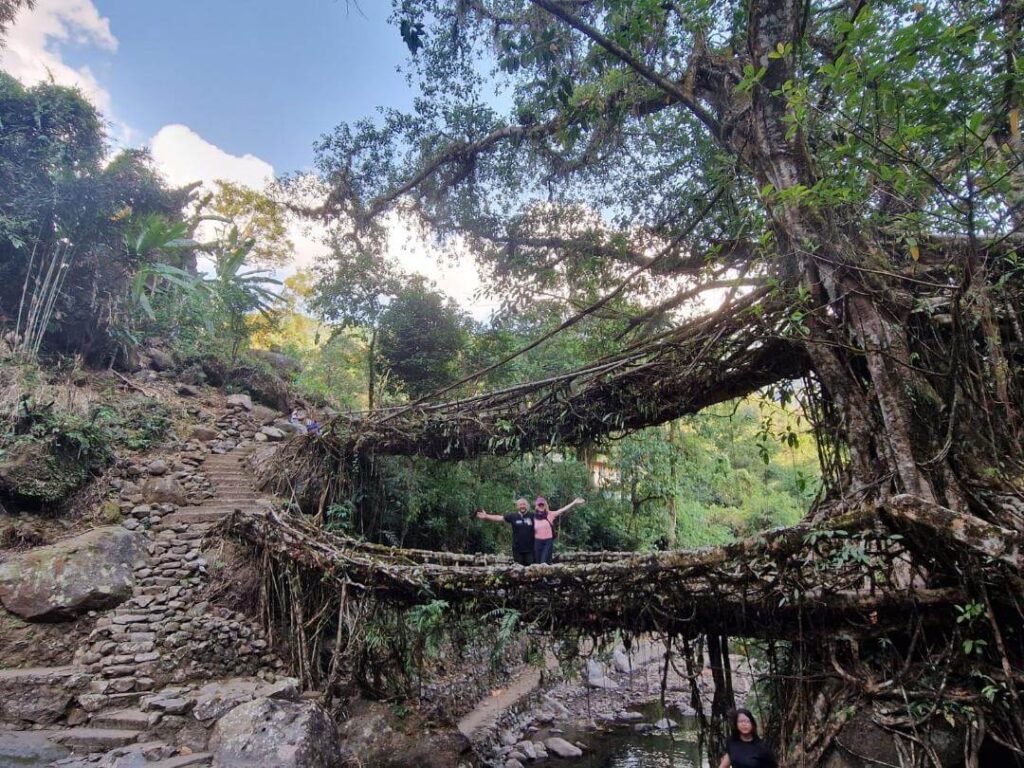
What to expect when visiting Meghalaya’s Living Root Bridges : Trek through India’s lush rainforests and across suspension-like root bridges that feel like something out of a fantasy novel. For lovers of nature and off-the-beaten-path experiences, this is one of the most unique landmarks in all of Asia.
When visiting the double-decker living root bridge in Nongriat, you can expect a strenuous trek, as it’s nestled deep in the hills and requires LOTS of steps – nearly 3,000 in total!! – down into a lush valley. Once you reach the Double-Decker Living Root Bridge, you’ll be greeted by its breathtaking design: two levels of interwoven tree roots forming a unique, double-decker structure that spans a river. Throughout this Meghalaya trek, you’ll come across several impressive living root bridges, but the highlight is undoubtedly the Double-Decker Living Root Bridge – and trust us, you will be amazed.
If you think this trek in Nongriat couldn’t get any better, think again – continue from the Double-Decker Living Root Bridge to discover the hidden gem of Rainbow Falls. Tucked away in the dense jungles of Meghalaya, this stunning waterfall creates a breathtaking rainbow effect when the sunlight hits it just right. It’s a truly unique sight and undoubtedly one of India’s most unique attractions, and without a doubt, a top landmark in Asia.
We absolutely fell in love with Meghalaya’s living root bridges – but fair warning, the trek to reach them is no joke! Read all about our trek to the Living Root Bridges and get those legs ready and maybe squeeze in some squats before you go.
In our opinion, visiting the living-root bridges in Meghalaya was hands-down the best attraction in India. For more one-of-a-kind Indian attractions, vibrant cultural festivals, must-visit cities, and practical travel tips, be sure to explore our India travel guides.
Best Travel Insurance– Even with the luck of the Irish, things can still go wrong. World Nomads Travel Insurance is our top choice for travel coverage. With the best transparent fine print in the industry, it’s no wonder they’re ranked number one. Don’t let your adventures turn into mishaps and get a free quote today!
16. The Potala Palace (Tibet)
Where is the Potala Palace located: Lhasa, Tibet Autonomous Region.
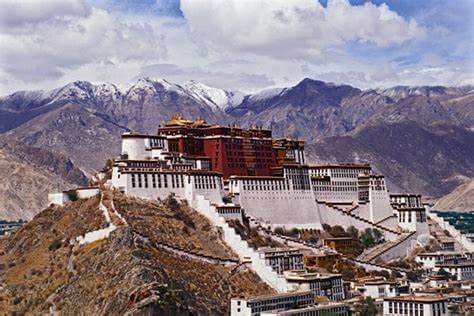
Why the Potala Palace is one of the best landmarks in Asia: The Potala Palace is on the list of Asia’s most remarkable landmarks due to its stunning architectural grandeur, deep cultural significance, and historical importance. The Potala Palace was once the winter residence of the Dalai Lama and is an iconic symbol of Tibetan Buddhism. Perched high on Marpo Ri Hill, the palace offers a striking contrast against the backdrop of the surrounding Himalayan mountains. The Potala Palace is a UNESCO World Heritage Site and serves as an important pilgrimage destination for Tibetan Buddhists. Its unique structure, a blend of Tibetan, Indian, and Nepalese influences, has made it one of the most visually stunning and culturally rich landmarks in Asia.
What to expect when visiting the Potala Palace: When visiting the Potala Palace in Lhasa, Tibet, expect a journey that’s both physically demanding and spiritually enriching. The palace sits high on Marpo Ri Hill, so there will be a bit of an ascent involved, but the panoramic views of Lhasa and the surrounding Himalayas make the climb worthwhile. There are only 300 steps to Potala Palace, so if you compare this to the 3000 steps to visit Nogriat’s Living-Root Bridges you’ll be grand! Once inside, you’ll be transported into a world of ancient Tibetan culture and Buddhist traditions. Potala Palace is vast, with 1,000 rooms, numerous chapels, and sacred tombs that house the remains of past Dalai Lamas. Expect to spend several hours exploring the impressive architecture, intricate murals, golden shrines, and statues.
*Be prepared for high altitudes – hasa sits at around 3,650 meters (11,975 feet) above sea level – so if you’re sensitive to altitude, take it slow and stay hydrated.
Top-rated Potala Palace Tour:
- A Spiritual and Cultural Tibet Experience over 4 Days: Explore Tibet’s spiritual heart, visiting Potala Palace, Jokhang Temple, Barkhor Street, Drepung, and Sera Monasteries. Immerse in rich culture and serene landscapes on this unforgettable journey.
17. Gyeongbokgung Palace (South Korea)
We are keeping with the palace theme in this next recommendation of the best landmarks in Asia:
Where is Gyeongbokgung Palace located: Seoul, South Korea.
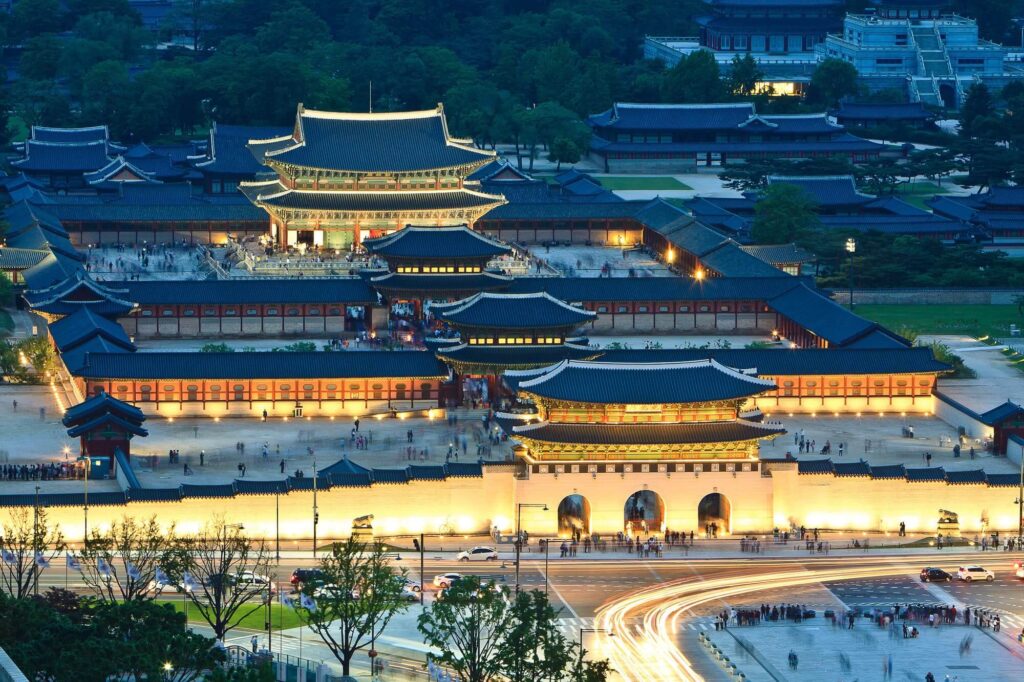
Why Gyeongbokgung Palace is one of the best landmarks in Asia: Gyeongbokgung Palace is on the list of Asia’s best landmarks because of its historical significance, architectural beauty, and cultural importance to South Korea. Located in the heart of Seoul, Gyeongbokgung is the largest and most grandiose of the Five Grand Palaces built during the Joseon Dynasty (1392–1897), and it served as the main royal palace for over 500 years.
What to expect when visiting Gyeongbokgung Palace: When visiting Gyeongbokgung Palace in Seoul, expect to step back in time and experience the grandeur of Korea’s royal history. Expect to be awestruck by the stunning designs of the palace’s gates, buildings, and pavilions, all surrounded by serene gardens and the backdrop of Mount Bugak. Once inside, you’ll explore the Geunjeongjeon Hall, where the king once held official ceremonies, and the beautiful Gyeonghoeru Pavilion, which sits on a tranquil pond. The palace also has several museums, including the National Palace Museum of Korea and the National Folk Museum, where you can learn more about Korea’s royal past and cultural heritage. A unique highlight of visiting Gyeonbokgung Palace is the changing of the guard ceremony, held at the main gate. This colorful and traditional event, which happens several times a day, offers a glimpse into the court rituals of the Joseon Dynasty and is a must-see for visitors.
The Gyeongbokgung Palace stands as a symbol of Korea’s rich heritage and a popular landmark in Asia for those interested in history and architecture.
Top-rated Gyeongbokgung Palace Tour:
- Step back in time at the Gyeongbokgung Palace and the Bukchon Hanok Village on this guided walking tour in Seoul and enjoy some tasty snacks along the way.
18. Fo Guang Shan Buddha Museum (Taiwan)
Where is Fo Guang Shan Buddha Museum located: Kaohsiung, Taiwan.
Why Fo Guang Shan Buddha Museum is one of the best landmarks in Asia: Taiwan’s Fo Guang Shan Buddha Museum is home to Asia’s largest seated bronze Buddha statue, standing at an impressive 108 meters tall. This monumental figure is a central symbol of Taiwan’s Buddhist heritage and a must-see for travelers seeking spiritual and architectural grandeur.
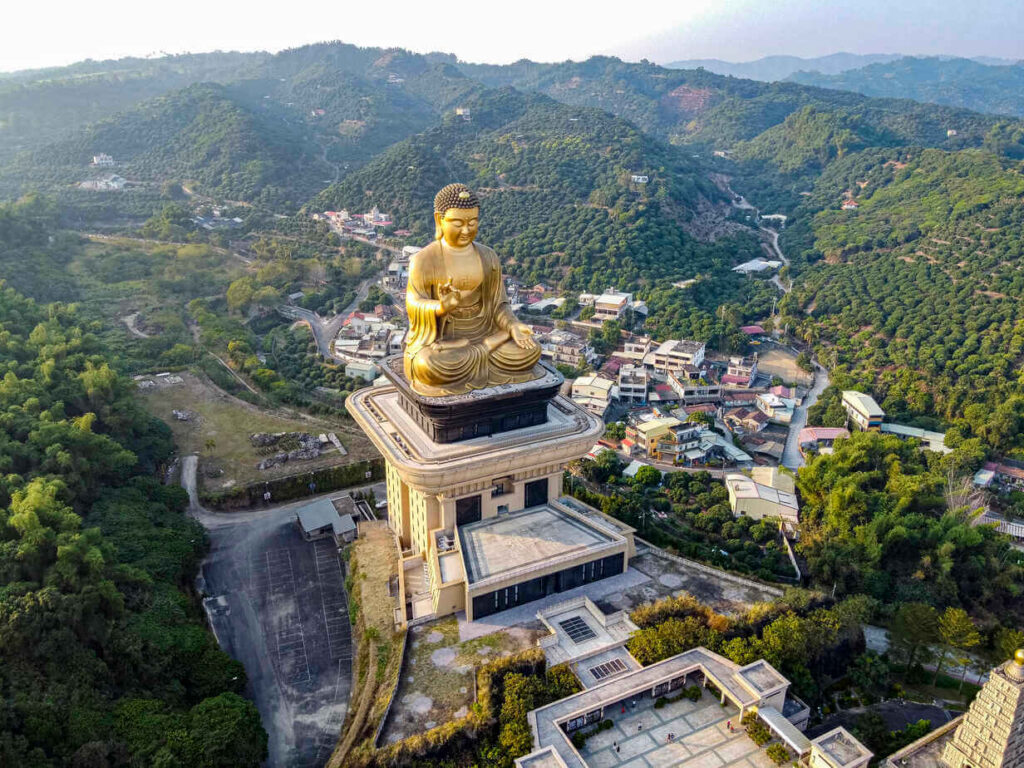
What to expect when visiting Fo Guang Shan Buddha Museum: Visitors to Fo Guang Shan Buddha Museum can explore a vast complex that includes eight pagodas, themed exhibition halls, and serene gardens. The museum’s Main Hall houses the Jade Buddha Shrine, which enshrines a revered tooth relic of the Buddha. The site offers a profound cultural experience, blending art, spirituality, and history. We just randomly came across this Taiwan attraction after seeing a poster for it in an elevator – and thankfully we did as now it has made our list of best landmarks in Asia!
Top-rated Fo Guang Shan Buddha Museum Tour:
- Embark on a private city tour in Kaohsiung, including visits to the Fo Guang Shan Museum, Museum of Fine Arts, Pier 2 Art centre & Love River.
If you’re planning a visit to this incredible attraction in Taiwan, make sure to give yourself plenty of time – there’s a lot to explore at the Buddha Museum. And before you go, don’t miss our list of the top 13 things to know before visiting Taiwan.
19. Halong Bay (Vietnam)
Where is Halong Bay located: Quang Ninh Province, Vietnam.
Why Halong Bay is one of the best natural landmarks in Asia: With its towering limestone pillars and emerald green waters, Halong Bay is an iconic natural landmark in Asia. It’s a UNESCO World Heritage site and one of the most picturesque places in Vietnam.
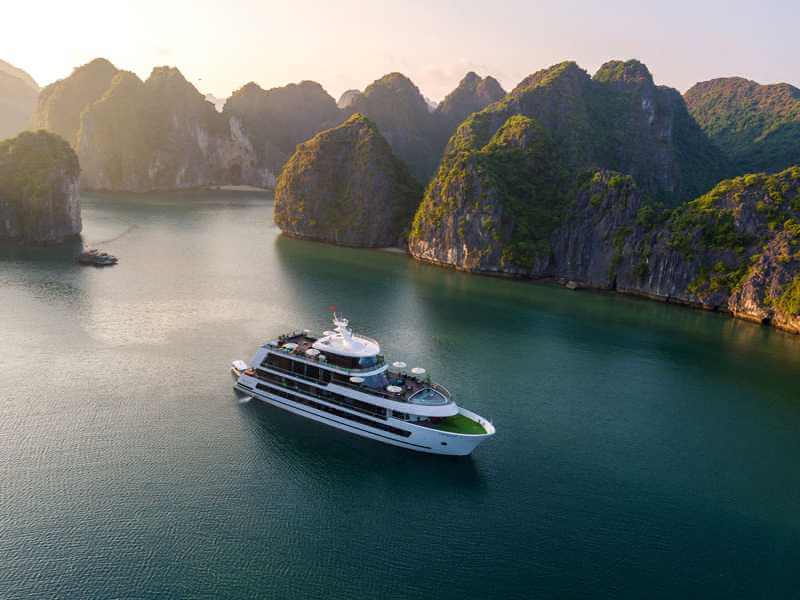
What to expect when visiting Halong Bay: A boat tour through Halong Bay is an absolute must if you’re visiting Vietnam. Cruising between Halong Bay’s towering limestone cliffs and emerald waters feels like drifting through a dream. Along the way, you can kayak through hidden lagoons, explore ancient caves, and soak up the peaceful beauty of this UNESCO World Heritage site. It’s one of the most unforgettable ways to experience Vietnam’s natural magic. A cruise through Halong Bay is easily one of the most popular things to do in Vietnam.
We love Vietnam! In fact, Vietnam was the very first country we landed in when we left Ireland back in 2016 – let’s just say it took us a few days to cross the road! From the wonderful chaos, the food, the affordability – we were hooked!
Top-rated Halong Bay Tours:
- From Hanoi: Full-Day Halong Bay Cruise with Swimming & Kayak Tour
- From Hanoi: 3-Day and 2-Night Cruise Stay at Bai Tu Long Bay
We’ve had the chance to go on this 3-day, 2-night Halong Bay cruise twice – once when we first visited Vietnam in 2017, and again in 2018 when we brought our parents along to share the experience. There’s something truly magical about waking up to the stunning views of Halong Bay right outside your cabin window. It’s easily one of the most amazing experiences in Vietnam.
20. The Terracotta Army (China)
Where are the terracotta Warriors located: Xian, Shaanxi Province, China.
Why the Terracotta Warriors are one of the best landmarks in Asia: The Terracotta Warriors are on the list of the best landmarks in Asia due to their extraordinary historical significance, sheer scale, and the captivating story behind their creation. Discovered in 1974 near Xi’an, China, this vast army of over 8,000 life-sized soldiers, horses, and chariots was buried with the first Emperor of China, Qin Shi Huang, to accompany him in the afterlife. Xi’an’s Terracotta Warriors are considered one of the most important discoveries of the 20th century, offering a unique glimpse into China’s past. This historical treasure in China is now a UNESCO World Heritage Site and continues to draw millions of visitors each year, solidifying its place as one of Asia’s most iconic landmarks.
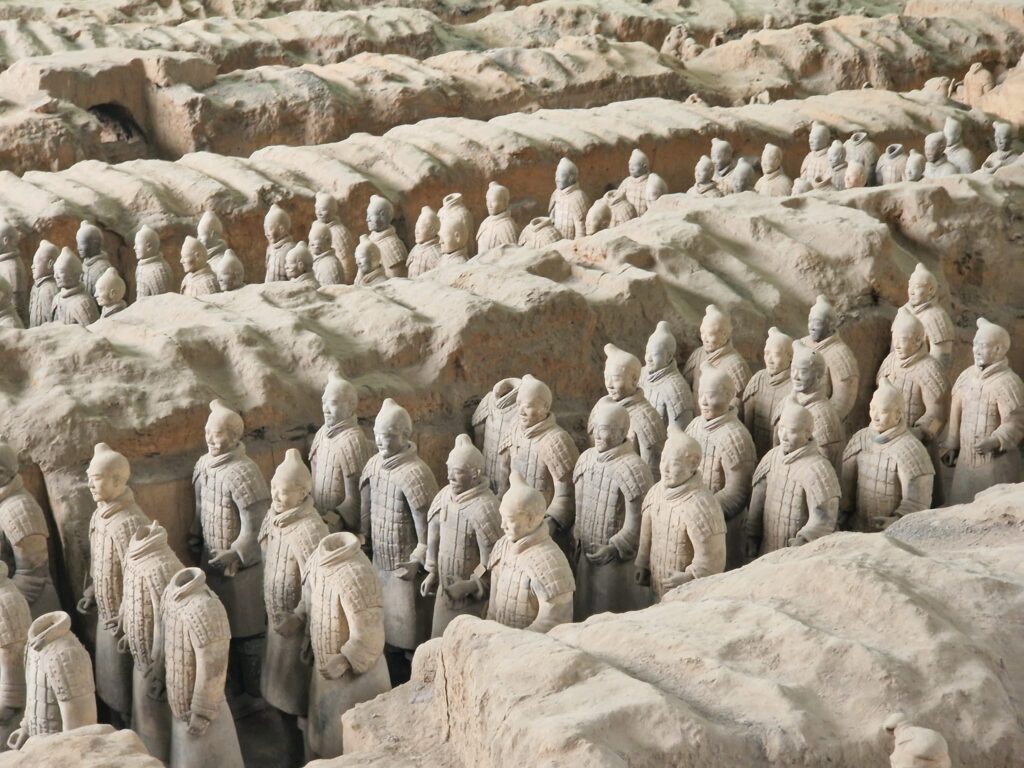
What to expect when visiting the Terracotta Warriors in Xi’an: When visiting the Terracotta Warriors in Xi’an, expect an awe-inspiring journey into ancient history. The site is vast, with several pits housing thousands of life-sized, meticulously crafted soldiers, horses, and chariots, each with unique features, from their expressions to their clothing. Upon arrival, you’ll first visit the main excavation pit, which is the largest and most famous, where you can view rows upon rows of soldiers in varying states of restoration. The sheer scale and attention to detail of the figures is just mind-blowing, with some standing in formation, while others are still being uncovered. The site includes a museum with exhibits that explain the fascinating history of the discovery of the Terracotta Army, the construction of the warriors, and the life of Emperor Qin Shi Huang, who ordered their creation to accompany him into the afterlife.
Top-rated Terracotta Army Tour:
During our 30-day China itinerary, we were blown away by so many incredible attractions, but nothing quite compared to the moment we first saw the Terracotta Warriors. Having read about them in history books since we were kids, actually standing in front of the famous Terracotta Army felt surreal. These unique statues in Xi’an completely blew our minds. Read all about the very best attractions in China.
21. Samarkand (Uzbekistan)
Where is Samarkand located: Samarkand, Uzbekistan.
Why Samarkand is one of the best landmarks in Asia: Uzbekistan is home to some of the most beautiful cities in the world, and Samarkand is at the top of the list. We’ve included it as one of Asia’s most iconic landmarks because of its rich history, stunning architecture, and significant role as a key hub of the Silk Road. Once the capital of the Timurid Empire under Tamerlane (Timur), Samarkand was one of the most important cities in the medieval world. Its history, blending Persian, Turkish, and Central Asian influences, is reflected in its impressive mosques, mausoleums, and madrasas (Islamic schools), all contributing to its unique beauty.
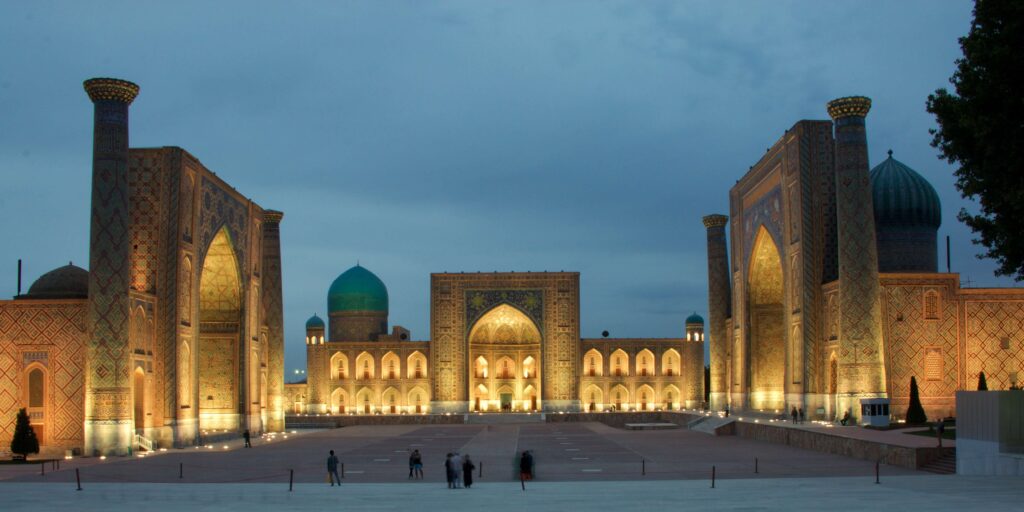
What to expect when visiting Samarkand: Walking through Registan Square feels like stepping into another era. The intricacy of the architecture, the detailed mosaics, and the sheer scale of the buildings make it one of the best landmarks in Asia. The Bibi-Khanym Mosque, Shah-i-Zinda, and Gur-e-Amir Mausoleum are also must-visit sites in Samarkand, each telling a story of the city’s role in the Silk Road trade and cultural exchanges. While exploring, expect to walk through lively streets, with local markets offering a mix of traditional crafts, textiles, and delicious food. In all, Samarkand offers a unique and immersive experience, combining historical exploration with the charm of a city that once sat at the crossroads of the world and is easily the most beautiful city in Asia.
Top-rated Samarkand Tour:
- Discover the vibrant culture and rich history of Samarkand on a half-day morning tour.
If you are continuing your Central Asia travels, find out how to get from Samarkand to Panjakent Tajikistan. Even better, check out our Ultimate Central Asia Itinerary to experience the very best of what Central Asia has to offer.
How Many of Asia’s Best Landmarks Have You Visited?
We’ve covered some of the best landmarks in Asia, but there’s so much more to discover! From the towering peaks of the Himalayas to the intricate carvings of Angkor Wat, Asia is packed with history, beauty, and mystery.
You’ve probably picked up on the fact that we tend to gravitate toward natural landmarks – especially in Asia. What can we say? Nature just blows us away, and Asia’s natural wonders are on a whole different level. But that’s just our style. We’d love to hear about yours – do you prefer natural spots, cultural and historical sites, or a mix of everything when exploring Asia?
Whether you’ve visited none or many of these spots, we’d love to hear how many of these must-see landmarks in Asia you’ve checked off your list.
And if you think we missed any iconic sites, let us know in the comments. We are always looking to add most of the best landmarks in Asia to our list.
Feel free to leave a message below or contact us on our socials.
Slán go fóil


This post contains affiliate links. If you click on the links to make a purchase, we will earn a small commission. This is at NO EXTRA COST to you. This is a free way to support us and allow us to continue to create inspiring adventure travel guides.


